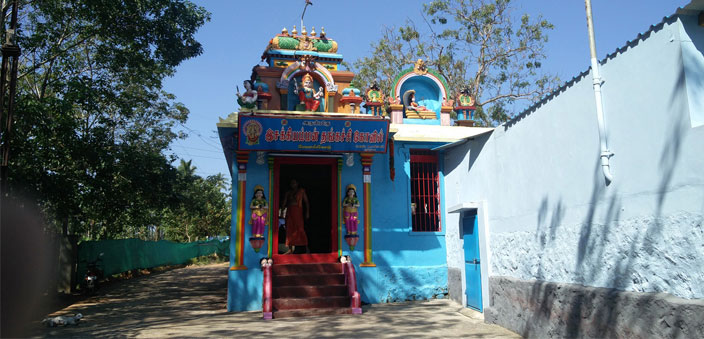Walking into the Melamcode Devi temple, I felt my stomach twist with excitement. I wasn’t religious in the least, but the stories I’d heard about this set of temples had turned it from a place that gave my grandmother as much joy as it gave me a sense of boredom (I had been dragged to far too many temples on this trip to Kerala), then into one that was drenched in magic.
This was my family temple, my ‘kudumbakshetram’, maintained by my ancestors from my mother’s bloodline until four generations ago, when it had to be handed over to the Devaswom Board. They sit nestled in the hills, surrounded by trees. It had taken two hours to drive from Trivandrum to Thuckalay, and the scenery had just grown more picturesque as we left the outskirts of the city. Its beauty had pretty much hit its peak near the temples, with tall trees casting a gorgeously cool shade over us. The first temple had the typical whitewashed look of Kerala temples, but the second temple sat like a little blue jewel in the earth, true to Tamil temple design, Thuckalay now being a part of Tamil Nadu.
The legend
It looked like an innocuous little building, but to me it had a slightly eerie atmosphere. The history of this temple made the idol of the Devi, with her rebellious expression and her dagger, truly rather frightening. She was supposed to be Ummini Thanka, a princess from times past. As descendants of the Devicode Tharavad, we are supposed to be connected in some way to the Melamcode Amman temple, a link that is frustratingly hard to pinpoint thanks to our spottily recorded family history, but her story is fascinating either way. Centuries ago in Travancore, now Kerala, her father, the king Rama Varma, had promised her mother (supposedly a princess from Ayodhya), that their children would be his heirs, ignoring the matrilineal (Marumakkathayam) system that specified that his sister’s eldest son was actually the rightful heir. Thus, when his nephew, Marthanda Varma, ascended the throne, Ummini’s brothers – Padmanabhan Thampi and Raman Thampi – were purple with rage. They wanted to murder their cousin, and there were those who were willing to assist them; the Ettuveetil Pillamar, a cruel group of aristocrats who were accustomed to wielding more power than the king.

Marthanda Varma, determined to be a stronger ruler than his uncle, threatened to take this power away from them and they were just as eager as his cousins to kill him. They conspired with the Thampis, and consequently, the two brothers slipped away to Nagercoil Palace to kill their cousin. Raman was slain by the sentries guarding Marthanda Varma’s bedchamber, but Padmanabhan managed to sneak inside. Bloodthirsty, he pounced on his sleeping cousin, only to have his sword wedged in the low ceiling of the room. This gave Marthanda Varma enough time to recover from his shock, and kill his cousin before he had a chance to murder him. Outraged, he then proceeded to imprison his aunt and kill her too. However, he wanted to marry Ummini Thanka. Unfortunately for him though, Ummini, overwhelmed by grief and rage, cursed her cousin, declaring that he would never have any daughters – which of course, amounted to the death of his bloodline. She then, very gruesomely, is said to have killed herself by wrenching out her own tongue. Alternative stories say that she stabbed herself or that Marthanda Varma added her to his list of victims. Her spirit then roamed the earth as a ‘yekshi’, a minor goddess, before this temple was made to appease her spirit, along with one for her mother.
Just superstition?
I stared at the striking, golden face of her statue, feeling an odd mix of fascination and fear — a kind of ‘horror movie’ fear. Fear of the supernatural that grips you quite powerfully, but yet doesn’t fully take hold of you as you keep telling yourself it’s not real. It’s fiction, born from the mind of just another human, and so how can you really be afraid of it?
That’s what this could well be; fiction. Ummini Thanka may have had an untimely death, but there’s no way to verify such folklore. It was only when my mother and grandmother shared a story with me, narrated to them by my own great grandmother, that I began to believe the legend. Tradition demands that the women of the Devicode Tharavad visit the temple when we marry, and then with our infants. In the old days, statues of mother and child were made and placed in the complex, life size terracotta figures, the mothers cradling a baby in one arm, carrying a dagger in the other hand. A few decades ago, my great-grandmother’s cousin’s daughter-in-law didn’t make the customary visit to the temple as a bride, going instead, along with her mother in law, when she was expecting her first child. She carried with her a piece of silk as an offering for the Devi, instead of the traditional nine-yard silk sari. However, she had forgotten the cloth in the car and the two of them entered the temple empty handed. As they walked into the little building, a woman bent over in prayer suddenly stood up. She made her way to my relatives, much to their surprise for they had never seen her before in their life. She looked fierce, this strange young woman, and she proceeded to berate the two of them. She spoke to them in Malayalam, chiding my grandmother’s cousin for coming to visit her so late, and for only bringing her a piece of silk. No, that wouldn’t do at all. She demanded to be offered the traditional chela. Seeing their terrified faces, she quickly assured them that despite this no harm would come to the unborn baby. The two of them nodded, white-faced but relieved, and rushed to Nagarcoil – the closest large town – to buy the Devi her sari. They returned to the temple and reverently placed the offering at the idol’s feet. The young woman who had been in the trance had no recollection of the incident whatsoever.
There have reportedly been several other instances of young women falling into a trance at the temple, and speaking the words of the Devi in tongues that they themselves don’t understand. Of course, it’s all quite difficult to believe. I myself was incredulous, and I still am. But the stories stirred something up in me, and I was bursting with anticipation as I walked into the temple and up to the idol of the Devi. Mother and baby statues were lined up beside her, representing various women of my extended family. I stood alongside them, praying to the Devi, and silently hoping that someone would fall into a trance.
However, my visit to the temple ended without a single stranger rolling back her eyes and scolding me. I was really rather let down, and frankly felt a bit cheated. Nevertheless, the stories surrounding these gorgeous little temples had still made it worth the visit, even for me. And I wasn’t completely disappointed. I was determined to go again, to experience one of these trances myself. Certainly, it might never happen – I had to admit that – but the excitement of knowing it could, has ensured that there is at least one temple I will never complain about visiting!


